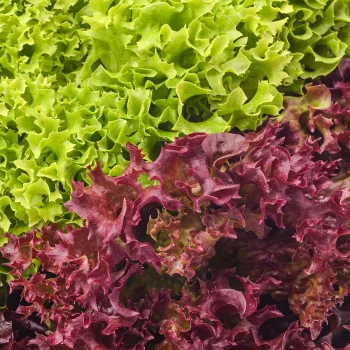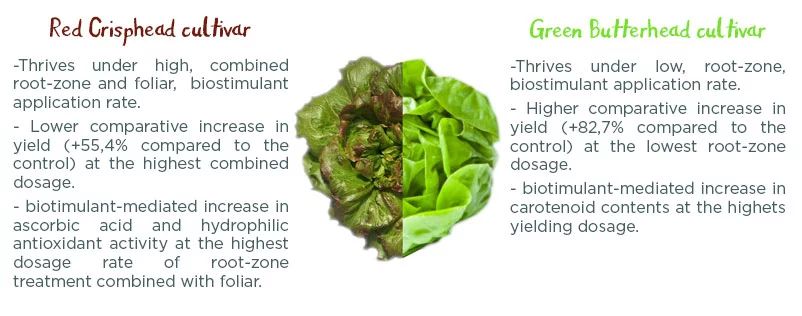UNDERSTANDING GENOTYPE X BIOSTIMULANT INTERACTION IS ESSENTIAL FOR DEVELOPING BIOSTIMULANT APPLICATION PROGRAMS TO IMPROVE TARGETED CROP TRAITS
By: Francesco Cristofano, Christophe El-Nakhel
Department of Agricultural Sciences, Università degli studi di Napoli ‘Federico II’, Portici (Italy)
*Correspondence: f.cristofano@gmail.com ; nakhel_christophe@hotmail.com

To fully express plants’ growing and yielding potential, contemporary research has been focused on the reduction of the effects of few factors that negate the achievement of this goal. Biotic and abiotic pressure indeed are major causes for reduced production outputs, and their effect can now be mitigated through a combination of optimal pest management, growing conditions and through the provision of the right amounts of water and nutrients, at the proper schedule. Nowadays, farmers benefit from the wide availability of products like biostimulants, which are deployed to help achieve the goal of increased stress resilience and yield by modifying plants’ metabolic and physiological processes in a way that is yet to be completely elucidated. Biostimulants are defined as ‘functional ingredients’ in plant nutrition, distinct from fertilizers and plant protectants. Research has compiled a long list of evidence regarding the use of biostimulants and their adherence to the claims of the EU regulation 2019/1009. Biostimulant-treated plants enjoy a variety of advantages compared to their untreated counterparts; growth increases found in literature are correlated with the induction or the production of plant growth promoting substances, improved nitrogen metabolism, and increases in plant stress-averting compounds. Such compounds like ascorbic acid are considered as human health improving substances, and may render suboptimal growing environments less taxing to yields. Indeed, many plant traits are responsive to modification via the extrinsic application of bioactive substances.
However, the presence of multiple biostimulant categories, e.g. protein hydrolysates and seaweed extracts, application rates, modality and agronomical conditions may prove to be a riddle to those uninitiated to these practices. For practical applications, aside from specific formulations, which can include gelatin capsules and seed treatments, research has been well established on the use of foliar treatments and root-zone application.
Biostimulants are applied to leaves via the use of sprinkler, overhead or manual spraying systems and their uptake by plants is through the cuticle, epidermal cells and stomata where they are readily absorbed. In fact, fast absorption makes foliar applications favored when a short-term quick response is required. Nonetheless, foliar applications are subjected to a variety of factors including climatic and genotypical. In fact, absorption modeling in research shows that high humidity, calm air, repeated applications and high leaf porosity are paramount to express the full potential of the biostimulant effect. These conditions are often found in protected agriculture, where the possibility of fine tuning of the cultivation environment is available, whilst field crops may sometimes incur in reduced efficiency, where more interaction is expressed between the environmental conditions and the biostimulant use.
In the latter cases, biostimulant applications via fertigation could be employed, due to the direct administration of these substances to the root zone. Root zone applications of biostimulants also provide for indirect benefits to crop growth that are related to this mode of application, like increased mineral nutrition availability in the soil or rhizosphere, due to nutrient mobilization and better soil health as a result of an increase in soil microbiota populations; furthermore, also recorded in literature is the betterment of soil physicochemical characteristics. Again, this solution also provides some tradeoffs due to the inherent absorption delay due to the biostimulant-growing media interaction, and for example, the reduction of the efficiency of protein-based biostimulant application to the soil may be reduced by the presence of organic-nitrogen feeding microorganisms. Nevertheless, in controlled environment conditions, the addition of biostimulants in hydroponics nutrient solution for the growth of horticultural crops, may downsize the application of fertilizers and boost vegetables quality, while remaining completely available and permanently in contact with plant roots. In fact, biostimulants increase plant nutrient uptake and nutrient use efficiency, and their effect is an outcome of several components that operate at diverse concentrations.
On the other hand, genotypical factors also play an important role in determining the success of biostimulation. Lettuce (Lactuca sativa L.) as an example, is one of the most cultivated horticultural crops which possesses great genetic diversity. In fact, the six most commercialized and commonly recognized lettuce groups, i.e. Crisphead, Romaine, Butterhead, Leaf, Latin and Stem, that differ in leaf shape, size and head formation. These traits alone may make for differences in biostimulant absorption through the leaves, as they may or may not interfere with the foliar uptake process.
Cristofano and collaborators (2021) compared two distinct lettuce genotypes, a green butterhead and a red crisphead, grown in a floating raft system and treated to nutrient solution, foliar and combined applications of a vegetal-derived protein hydrolysate biostimulant; the chosen biostimulant dosage rates were 3 ml L-1 for the foliar spray, as per the manufacturer’s instructions, and 0.15 and 0.30 ml L-1 nutrient solution – namely ‘low’ and ‘high’ dosage, respectively- for the nutrient solution applications.
The experiment proved a cultivar and treatment-specific response to biostimulant usage: whilst the green butterhead recorded a 82.7% increase (35.6 to 65 tons ha−1) in marketable yields with the low dosage of the nutrient solution application, the red cultivar thrived at the highest application provided by the combined foliar spray and high nutrient solution rate, which resulted in 55.4% higher yields (45.2 to 70.3 tons ha−1). Further differences in genotype and mode of application were also found in the leaf phytochemical contents. The combined foliar plus high nutrient solution applications of the biostimulant elicited the highest increase in antioxidant activity, ascorbic acid and mineral contents, in the red pigmented cultivar, whilst the green cultivar enjoyed higher carotenoid contents when only treated with a low dosage of nutrient solution application. Lastly, authors also found that the two cultivars behaved differently towards increasing biostimulant dosages, as the green butterhead cultivar recorded decreased yields by 18.3% when the combined high dosage x foliar treatments were administered, when compared to the best performing nutrient solution treatment.

Genotype and dosage-derived modulation of plant growth and fruit yield parameters were also found by Rouphael and collaborators in two distinct i.e. plum and mini-plum tomato (Solanum lycopersicum L. cultivars, which were grown in greenhouse conditions.
Researchers administered foliar treatments of the same vegetal-derived protein hydrolysate of the previous study at the rate of 2.5 ml L-1, or ‘low’ and 5ml L-1, or ‘high’. Results showed the latter dosage to significantly improve tomato fruit yield by 21.3% when averaged across cultivars, compared to both the untreated control and the low-dosage group. More interestingly, biostimulant applications also elicited a significant and cultivar-dependent shift in yield parameters, as ‘Sir Elyan’ (medium-size plum-shape fruit) exhibited 28.7% higher marketable fruit mean weight, whilst ‘Akyra’ (mini plum) showed a 13.9% increase in marketable fruit number m-2.
Furthermore, amelioration was also denoted in the fruit antioxidant composition when averaged across the used cultivars, especially when the 5ml L-1 dose of the biostimulant was applied; the results showed 260.0% more lipophilic antioxidant activity and 61.9% more hydrophilic antioxidant activity compared to the untreated control. In particular, lycopene content increased by 34.9% and total ascorbic acid by 35.8% at the same dose. In addition, K and Mg concentration in fruits increased by 10.5% and 28.3%, respectively, at the same high dose.

The results obtained by the preceding studies showed that whilst the employment of biostimulant is undoubtedly lucrative on a cost and yield basis, further research efforts may be needed to better understand the intricacies between genotypical features and biostimulant applications, which add another piece to the puzzle of the strive for the sustainable intensification of agricultural practices.
Cristofano, F., El-Nakhel, C., Pannico, A., Giordano, M., Colla, G., & Rouphael, Y. (2021). Foliar and root applications of vegetal-derived protein hydrolysates differentially enhance the yield and qualitative attributes of two lettuce cultivars grown in floating system. Agronomy, 11(6).https://doi.org/10.3390/agronomy11061194
Rouphael, Y., Colla, G., Giordano, M., El-Nakhel, C., Kyriacou, M. C., & De Pascale, S. (2017). Foliar applications of a legume-derived protein hydrolysate elicit dose-dependent increases of growth, leaf mineral composition, yield and fruit quality in two greenhouse tomato cultivars. Scientia Horticulturae, 226, 353–360. https://doi.org/10.1016/j.scienta.2017.09.007



